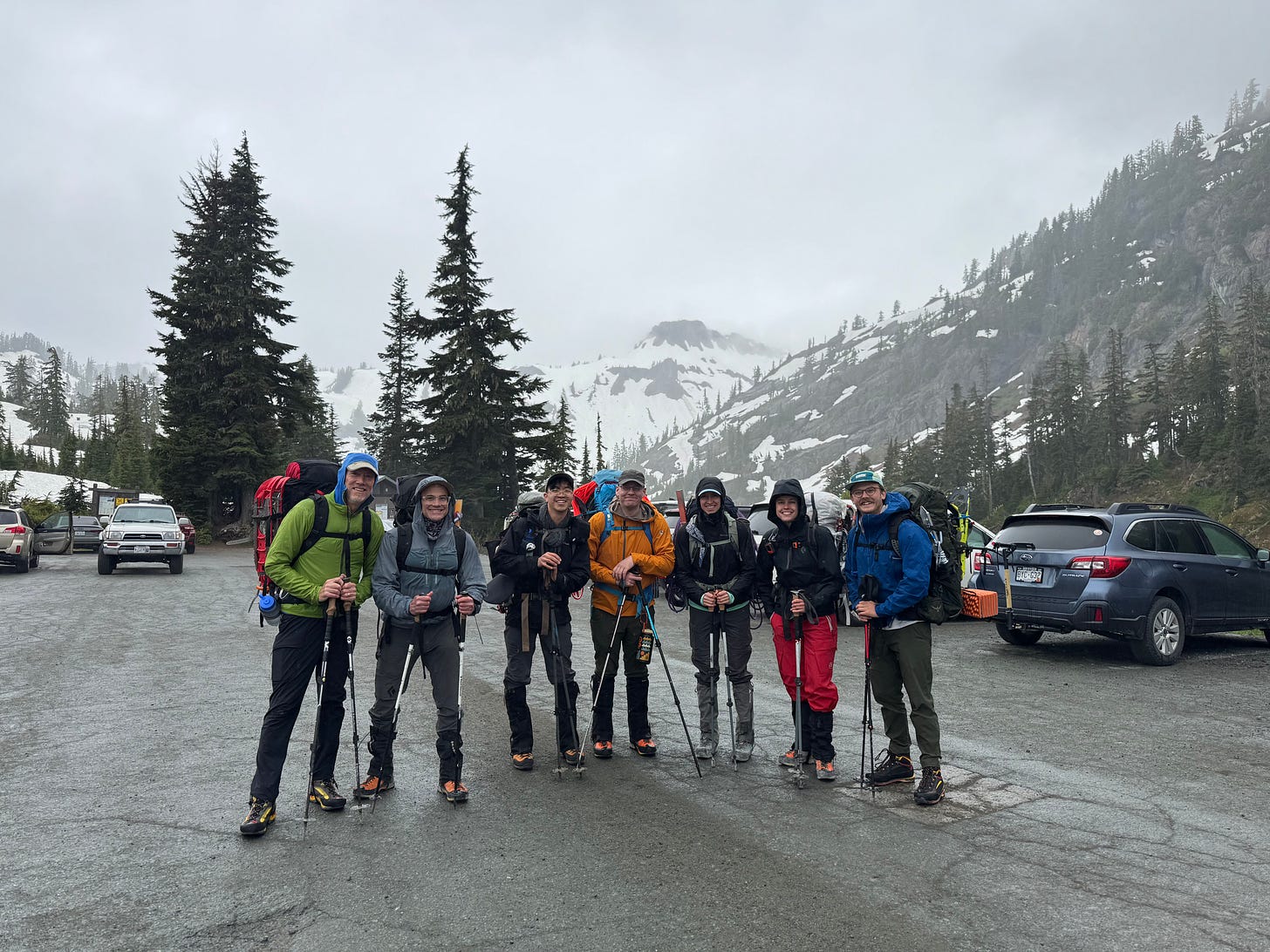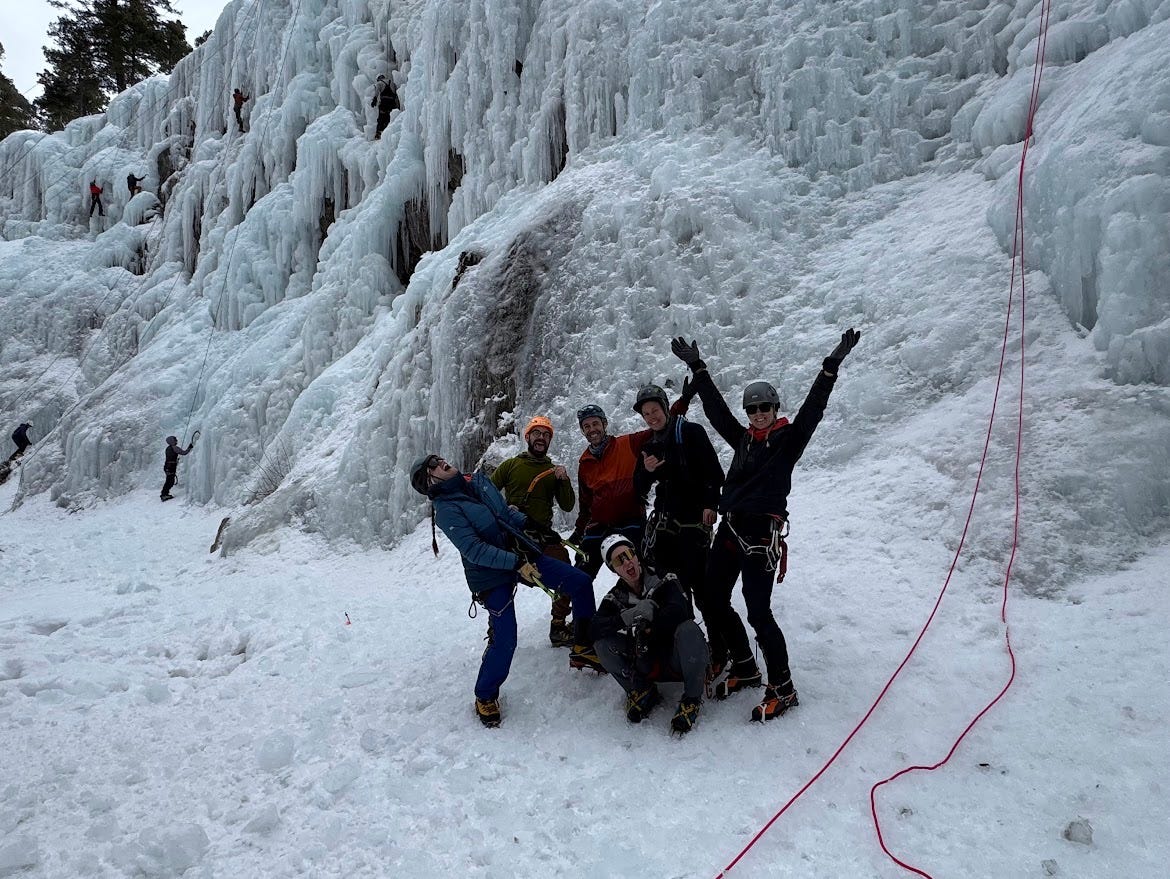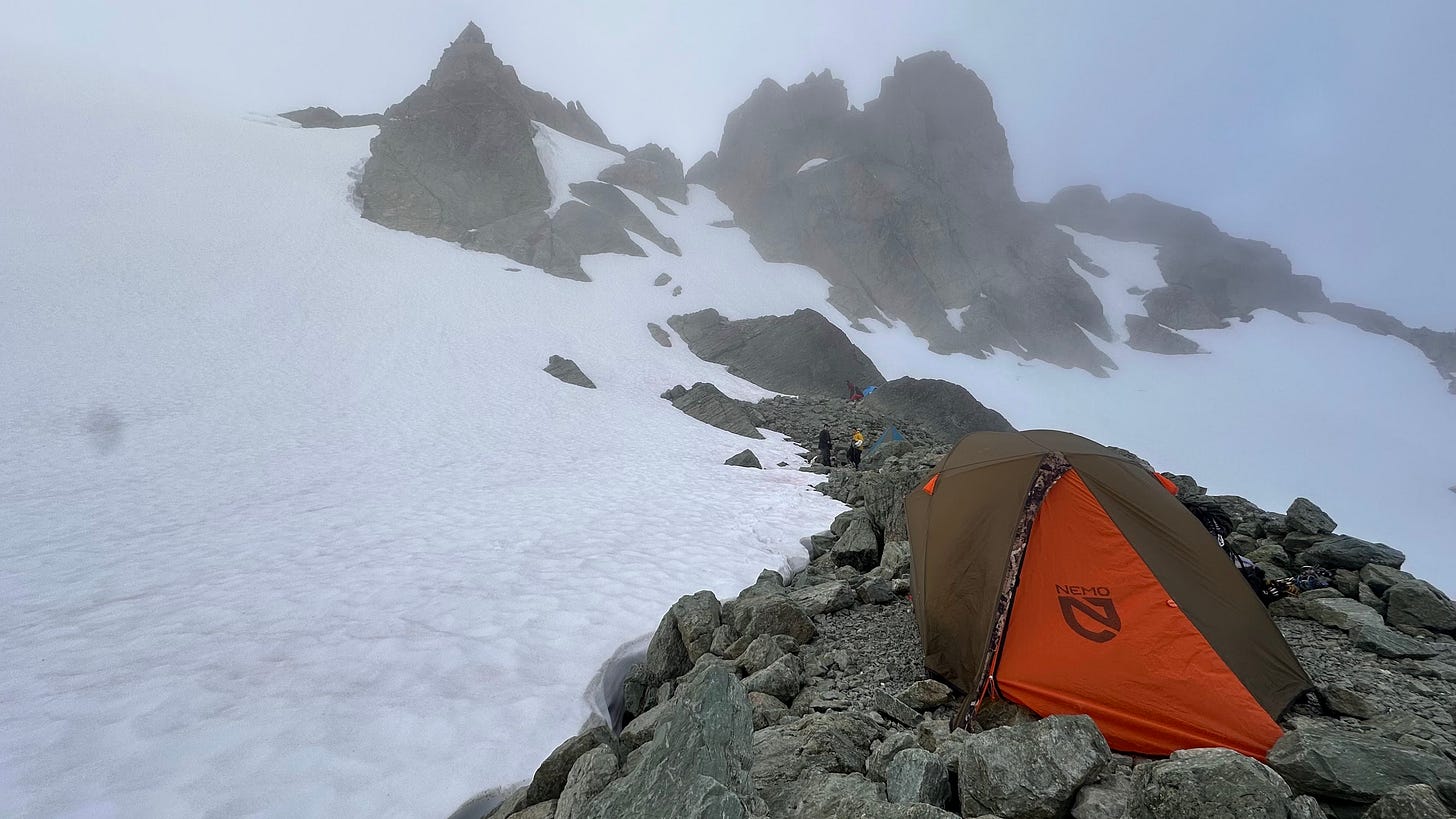Trip Report: Mt Shuksan via the Fisher Chimneys, Part 1
Nobody cares what mountains you've climbed and even fewer care about the stories you tell to your journal afterwards.
Trip dates: June 13-16, 2025.
Team Members (7):
Wally (Team Leader)
David
Colin
Jon
Breeyn
Dayton
Graham
Summit achieved? Yes.
Additional achievements unlocked:
First creek crossing face baptism.
First crevasse jumped.
First alpine rock leads (x2).
First alpine natural anchors constructed. A $20 webbing tithe left to the mountain gods.
First running snow belays.
First ascent of the Chimney route in 2025.
First time being stupid enough not to bring a sleeping bag.
First time running out of fuel and water at altitude.
Most number of hours lugging a useless pair of snowshoes around as training weights.
Narrative:
In May, I completed the Spokane Mountaineer’s 2025 Mountain School program. To complete the core curriculum of the class, we climbed Mt. Spokane, Steven’s Peak via West Willow Ridge, and Mt. Athabasca via the AA Col Glacier/Silverhorn route. Post-class, we were challenged to complete one graduation climb, obtain a Wilderness First Aid certification, and participate in at least one conservation event.
This is the tale of my graduation climb.

Assembling the Team
Back in December 2024, I met Wally while taking the Mountaineer’s ice seminar in Bozeman, MT. Wally is retired military guy with decades of mountaineering experience. He has a relaxed competence and self assuredness that I aspire to achieve one day. I also wouldn’t say no to growing in a similarly sick, dapple grey beard, if mountaineering grizzles me enough.
At one point during the ice seminar, he pulled me off the beginner wall that we had been running laps up all day and gently encouraged me to climb a frozen waterfall on the far end of the cliff. I was uncertain, but I had just peed in the woods, so it was physiologically unlikely that I would piss myself in front of the whole group in fear and Wally told me he believed I had it in me and that he would take the belay.
Inspired by Wally’s prompt, three of us in the class managed to climb the waterfall that day. Our group text conversations over the next week evolved from “Wow. That was a cool one-time experience, but probably beyond my risk tolerance.” to “…what if we got out there with no instructors and tried again on our own?”
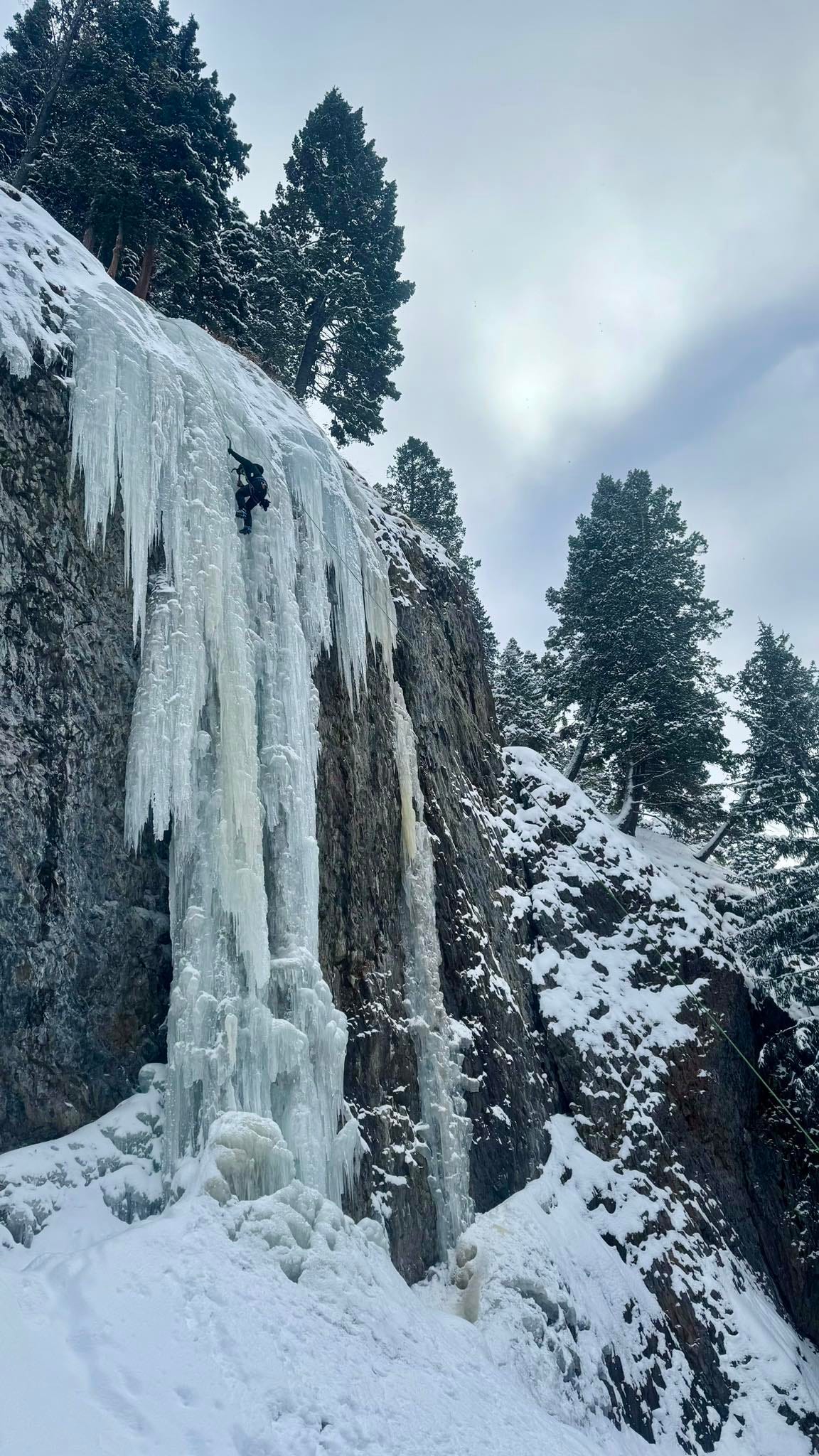
We rolled that Wally-inspired confidence boost into a follow up trip to Ouray, CO and filled two more days with dozens of challenging waterfall climbs. That trip was everything to me at that moment in time.
I moved to Spokane in August 2024. I had a few friends here, but no family within 2,300 miles and my entire life had just fallen apart. My 12-year relationship had ended. I lost my partner, my two dogs, my house, my truck, and I had just spent four lonely months living out of a suitcase in an airport hotel in Burien while attending the WA State Police Academy. My adrenaline systems were broken and firing at the wrong times. My mannerisms and instincts had all been methodically re-trained for law enforcement work. I didn’t know if I had made an irreversible mistake pausing my white collar water resources professional engineering career to try being a rough and tumble street detective. I wanted to see more sides of life and life decided to give it to me all at once.
The Spokane Mountaineers was my first grasp to find a stable lifeline. It seemed to promise an endless series of escalating, technical, adrenaline-filled adventures and - oh God, hopefully - true friends and deep connections in my new city. Life is fucking lonely.
Near the end of Mountain School, a message popped up on my Mountaineer’s account from Wally and Breeyn: “Mt. Shuksan - Fisher Chimneys?”.
I was in.
The Plan
Wally and I locked down a permit for 8 climbers on April 29 at 0700 hours on recreation.gov. Wally recruited the team. We did not hold a formal pre-trip meeting, but Wally discussed the trip with each of us and set up a group text thread that explained what additional gear he expected us to acquire (snow picket with 120cm sling and locking carabiner, 22cm ice screw, nut removal tool) and described the travel plans. We kept a continuous dialogue of Q&A in the weeks before the trip.
Day 1: Meet at the Glacier Ranger Station at 1300 hours. Depart to Bagley Lakes trailhead. Hike up the road to the Lake Anne trailhead. Climb 1500’, descend 800’ to Lake Anne. Camp.
Day 2: Ascend the Fisher Chimneys. Cross the glacier below Winnie’s Slide. Camp below Winnie’s Slide.
Day 3: Summit and descend through Fisher Chimneys (4450’) Camp at Lake Anne.
Day 4: Return from Lake Anne. Get started on our 7-hour return drive by noon at the latest.
Total Elevation Gain: 6750’
Summit Point: 9127’
In the end, we queued up with 7 climbers. Two of us - Colin and I - had just finished Mountain School two weeks before. We had climbed Athabasca successfully (11452’ summit with 6500’ gain), but this was going to be a new challenge with additional considerations for it being a multi-day adventure filled with Class IV and V scrambling, and ice/rock mixed terrain.
To up our technical skills, I crammed trad school in between Mountain School and the Shuksan trip to try and gain additional experience building natural anchors. Colin watched an irresponsible number of Youtube videos, pushed hard into upping his sport climbing skills, and experimented with a twin rope rappeling system.

Fitness-wise, we had both committed to several months of Colin’s “Peak a Week Training Program” where we ventured out and attempted small summits, ridgeline traverses, and moose encounters in the Cabinets every free weekend during Mountain School. Strict “Peak a Week” implementation involves one day of hard climbing and strict bed rest for 6 days after (kind of a reverse Genesis 2:2 training plan), but I snuck in some additional hours of Zone 2 bike cardio most nights with a 30 lb weight vest strapped on and multi-tasking my way through Skyrim on my Nintendo Switch.
The Trip
Day 1.
Wally checked in with the rangers at our rally point at 1300 hours while I blew through most of my Trader Joe’s gummy turtle snacks in the parking lot. The ranger had tromped out to Lake Anne on snowshoes the day before and recommended snowshoes for every member of our party.
I choked back a sob because I had just spent my budgeted MSR snowshoe money on one Petzl Nomic ice tool in a moment of REI sale weakness. I only own bulky, decade-old Costco snowshoes. Lugging them up the mountain meant that I had to say goodbye to a strong vision I had of myself mantling effortlessly over the final Fisher chimney and onto the glacier in my approach shoes, board shorts, suns out/guns out t-shirt, and the backwards Redbull hat that I had to go win in an ebay auction (because they don’t seem to want to sponsor filthy casuals who are mediocre at 10,000 hobbies instead of good at one).
The buzzkill rangers shared none of my vision and said it was winter conditions out there and that it was likely going to be a treacherous journey because no one had been up the Chimneys yet and most of the rappel stations were still under the snow.
Frowning, I tossed my board shorts and blue approach shoes back in my trunk and slammed it shut. Overall, our weather window looked delightful and we expected a blue bird day for our summit attempt, but - perhaps mirroring my mood post-breakup with my approach shoes - we started out from the parking lot in a light drizzle of rain at around 1400 hours.
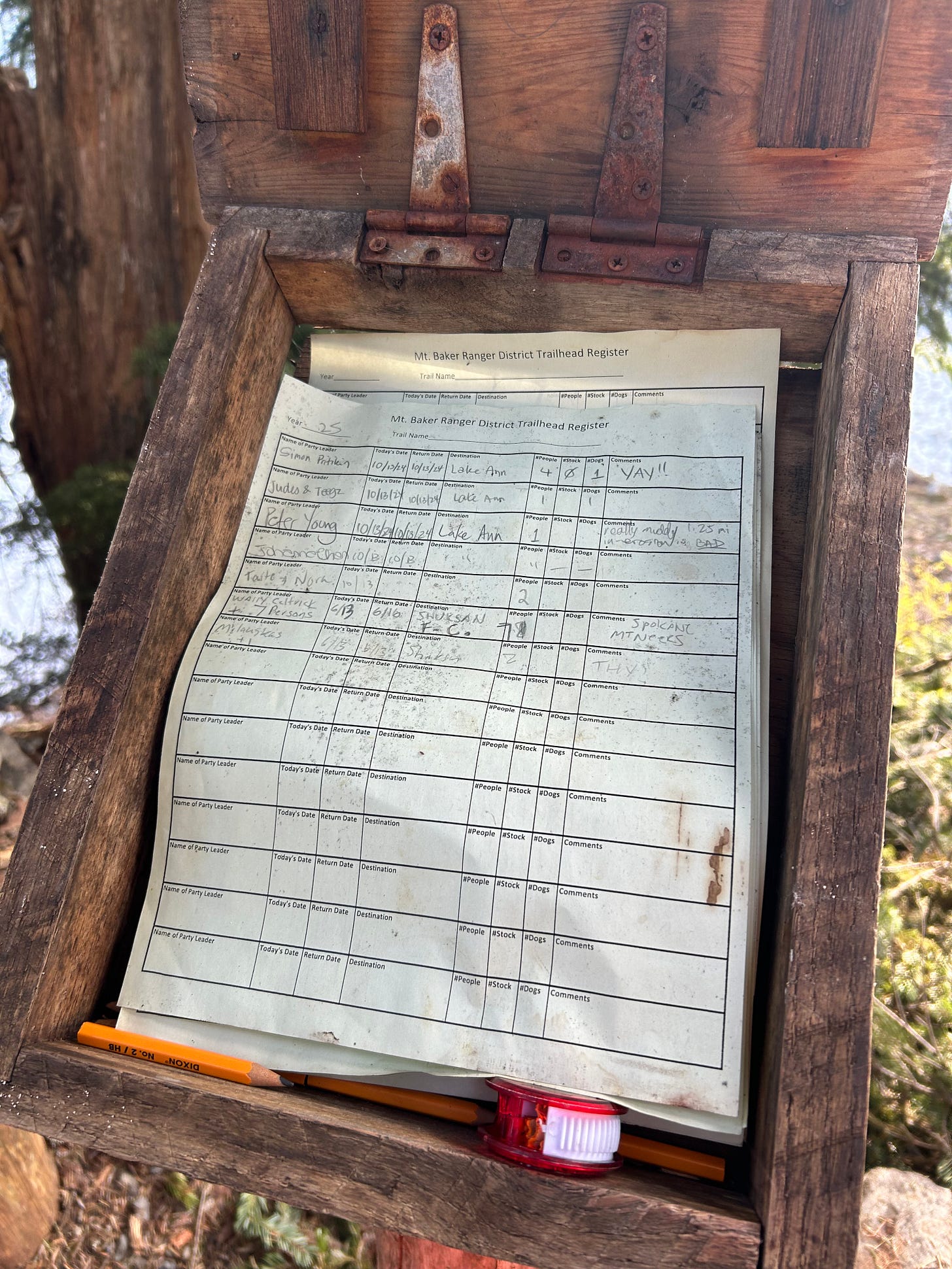
We found the Lake Anne trailhead after several miles of pavement and signed the trailhead log. It appeared that we were the first team up in 2025. The trail itself was a mix of mud and long stretches of afternoon snow. We slipped and slid our way down 800’ feet of trail and then navigated trail-less through a big, open valley with 3 creek crossings (2 substantial and 1 insignificant). After navigating to the correct drainage, we ascended 1500’ feet to Lake Anne through wet, warm snow. We estimated the snow coverage at approximately 90% snow. The group immediately fractured into two starkly opposed philosophical parties on the ascent - the stubborn boot packers and the overly optimistic snowshoers. I watched a lot of snowshoers tumble down angled terrain while side hilling and try to pretend like they enjoyed it.

Approximately 1700 hours, we settled in for the night up the hill from Lake Anne (5600’) and used a creek runoff as a water source. We were right on the border of the North Cascade park boundary. If you are camping in this area, there is exposed dirt below the tree line and you are permitted to bury waste, following standard leave no trace guidelines. If you’re nervous about the 6500’ of climbing you’re about to do, you can just hold it all inside of you for 3 days. One member of our party tried that approach. See their list of achievements for details.

As I settled in for the night, I immediately began to question my decision to forgo a sleeping bag. Everyone I had discussed this trip with had bemoaned how hot it had been and how they regretted carrying up so much gear. Instead of a sleeping bag, I thought I’d try just wrapping up in my puffy jacket, puffy pants, three pairs of socks, and my mittens.
I made it about 90 seconds, staring up at my breath freezing to the roof of the tent, before rolling over and pleading with my tentmate Breeyn to rapidly reclassify her sleeping bag as group gear.
Day 2.
We set a packs on start time of 0730 hours, so naturally we stumbled out of camp around 0830 hours. I was charged with leading this portion of the climb. We switchbacked up and up and up through non-glaciated snowfields to reach the base of the Chimneys. During this climb, we took time to practice moving as a roped team and setting running snow belays with our pickets. The snow was soft, but there were objective hazards in the area including rock fall, undercut snow, and an extremely consequential fall zone. Several members of the team did fall during the climb and had to self arrest.
We kept things light and topical and kept the group discussion to religion and the afterlife as we stared up at the Class IV and V scrambles that we were about to attempt. After one particularly dire self arrest, we mutually agreed to stop speculating on the probability of reincarnation for a couple hours.
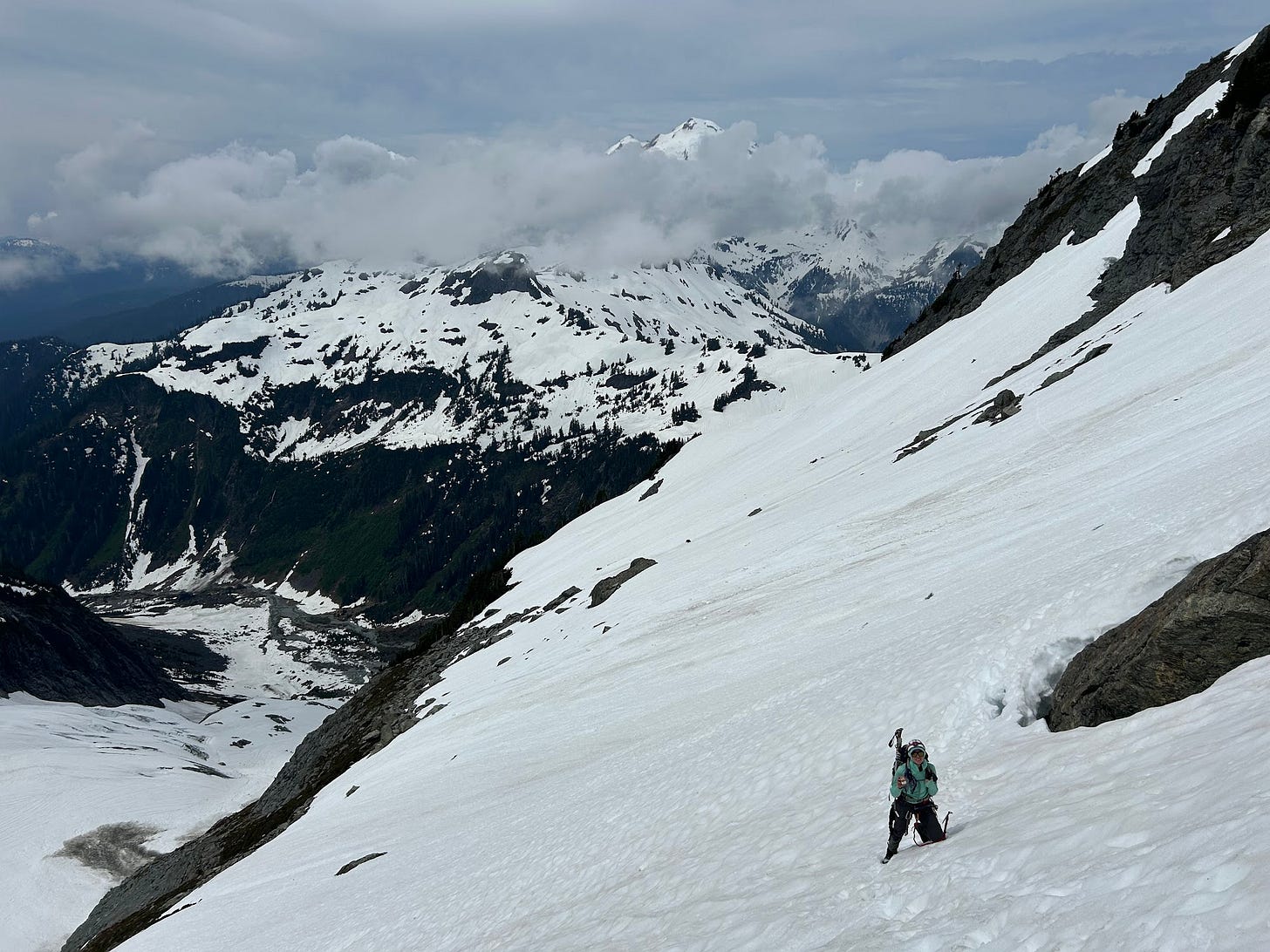
One struggle that becomes immediately apparent when moving with a team of 7 is that transition points become their own special kind of hazard. Moving from snow to rock or from rappel station to rappel station because an exercise in patience and careful movement. As we moved onto the base of the first rock chimney, we had to navigate off of an undercut ice shelf. There was not enough room at the base of the chimney to fit our entire party before beginning the next section of the climb and the ice was too angled to rest on, but we needed a beat to remove crampons and re-coil the two 70m ropes, and stow ice axes. Two members of our party ended up being jammed down in the ice cave formed by the edge of the moat.
It was easily 20 degrees colder in the ice cave and, while they initially kept their spirits high by describing their new glorious lives as ice trolls, stark reality set in when one of the ice trolls had to piss and the mystical beauty of the ice cave devolved into a tightly constrained moat for ice troll piss. I don’t think either ice troll has fully emotionally recovered from that exposure event even now.
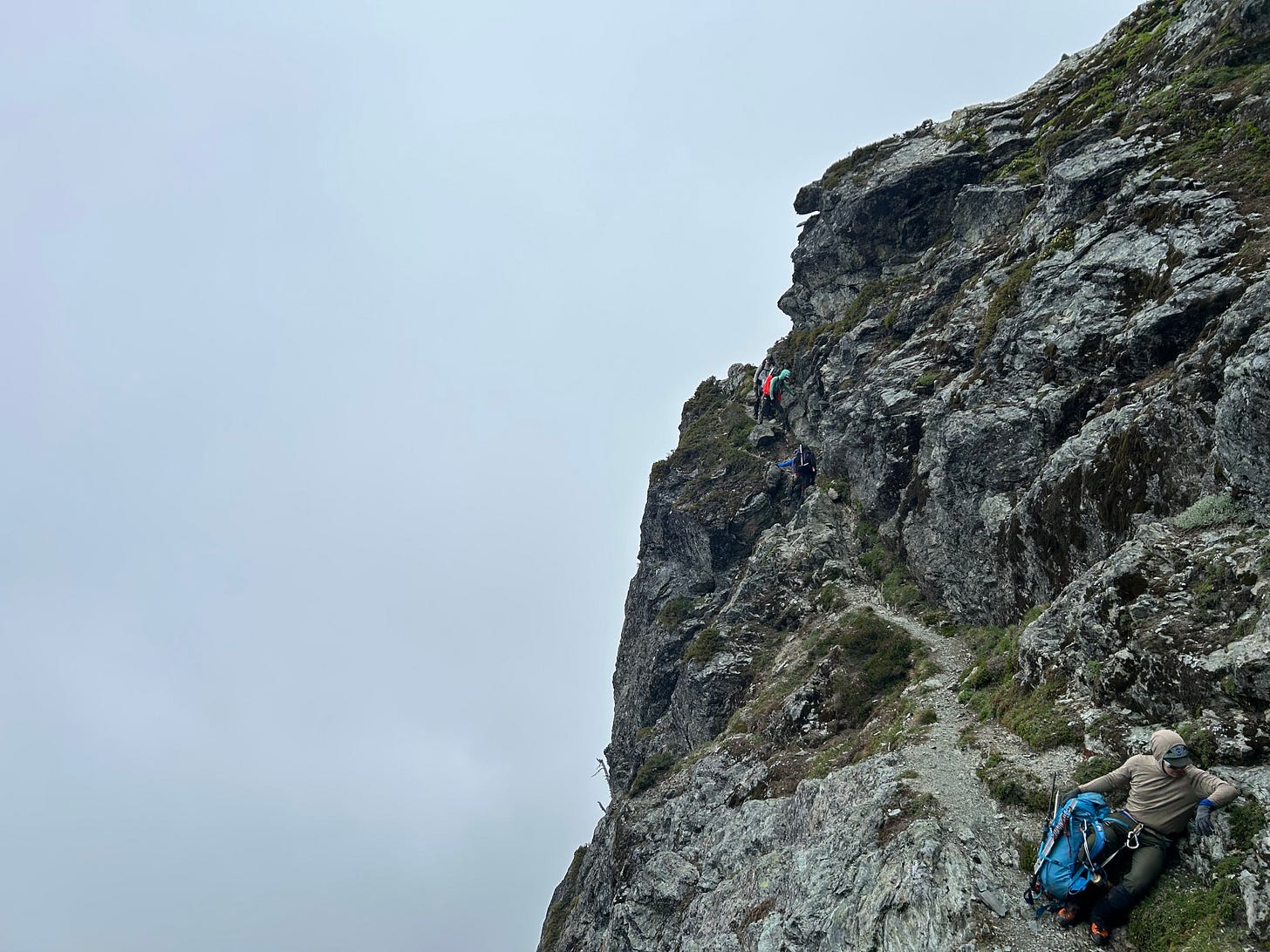
The Chimneys are incredible - even in winter conditions. I’m unsure what the actual count of “chimneys” is, but I would guess around 5 “climbs”. I felt comfortable free climbing all of the terrain in my pack, but - as a precaution because falls would be consequential - I often climbed up and set up to belay members of the team up, if they felt uncertain about free climbing. This could require establishing quick, simple natural anchors. There were some anchor stations available, however the high snow level likely obscured many stations.
The most challenging obstacle in our ascent was an approximately 700-ft, steep angled snow field. We had to navigate this field while roped together and deploying regular running snow belays. We eventually clambered up onto the rocks on the right side of the snowfield and free climbed to the summit, but - when rappelling down two days later - I seriously reflected on the risk level of that free climb. There were many, many loose rocks.


We topped out on the Chimneys at approximately 1700 hours. At the top of the Chimneys, we roped up for a short (approximately 20 minute) glacier travel to the base of Winney’s Slide. There were several rock windbreaks available to set our tents up. I’d estimate 3 spots on the upper rock band and 2 below. This is a glacier though, so wander carefully if you step or camp off the rock band.
There was some discussion on the pace we had been able to sustain with 7 climbers and if it was worth attempting a summit push the next day, or if it was wiser to just turn around and head back down in the morning. We decided that we wanted the summit and that 1000 hours would be our summit turnaround time and that we were probably signing up for an epic the next day. I didn’t know what epic meant, but it sounded cool, so I voted yes. Everyone else was also on board.
There were no seeps available for water, so we were forced to melt snow. Even conserving fuel by just melting the snow (then manually filtering) instead of boiling the water, my large fuel cannister and pocket rocket only got us through 4.5 liters of water before running dry. This didn’t seem dire at the time because we were under the illusion that seeps would be plentiful. I now think that seep searches are kind of like snipe hunts for first year mountaineers.
We tied bandanas over our eyes to block out the light and tucked in for a couple of hours of sleep before our alpine start. Still sleeping bagless, I whimpered like a sad puppy and shivered through a few fruit snack packs worth of calories until my tentmate took pity on me and let me put my frozen feet in her sleeping bag. I promise that I have other fine qualities.
This story continues in Part 2.





